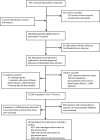Impact of neuraminidase inhibitors on influenza A(H1N1)pdm09-related pneumonia: an individual participant data meta-analysis
- PMID: 26602067
- PMCID: PMC4814862
- DOI: 10.1111/irv.12363
Impact of neuraminidase inhibitors on influenza A(H1N1)pdm09-related pneumonia: an individual participant data meta-analysis
Abstract
Background: The impact of neuraminidase inhibitors (NAIs) on influenza-related pneumonia (IRP) is not established. Our objective was to investigate the association between NAI treatment and IRP incidence and outcomes in patients hospitalised with A(H1N1)pdm09 virus infection.
Methods: A worldwide meta-analysis of individual participant data from 20 634 hospitalised patients with laboratory-confirmed A(H1N1)pdm09 (n = 20 021) or clinically diagnosed (n = 613) 'pandemic influenza'. The primary outcome was radiologically confirmed IRP. Odds ratios (OR) were estimated using generalised linear mixed modelling, adjusting for NAI treatment propensity, antibiotics and corticosteroids.
Results: Of 20 634 included participants, 5978 (29·0%) had IRP; conversely, 3349 (16·2%) had confirmed the absence of radiographic pneumonia (the comparator). Early NAI treatment (within 2 days of symptom onset) versus no NAI was not significantly associated with IRP [adj. OR 0·83 (95% CI 0·64-1·06; P = 0·136)]. Among the 5978 patients with IRP, early NAI treatment versus none did not impact on mortality [adj. OR = 0·72 (0·44-1·17; P = 0·180)] or likelihood of requiring ventilatory support [adj. OR = 1·17 (0·71-1·92; P = 0·537)], but early treatment versus later significantly reduced mortality [adj. OR = 0·70 (0·55-0·88; P = 0·003)] and likelihood of requiring ventilatory support [adj. OR = 0·68 (0·54-0·85; P = 0·001)].
Conclusions: Early NAI treatment of patients hospitalised with A(H1N1)pdm09 virus infection versus no treatment did not reduce the likelihood of IRP. However, in patients who developed IRP, early NAI treatment versus later reduced the likelihood of mortality and needing ventilatory support.
Keywords: Hospitalisation; individual participant data meta-analyses; influenza-related pneumonia; neuraminidase inhibitors.
© 2015 The Authors. Influenza and Other Respiratory Viruses Published by John Wiley & Sons Ltd.
Figures


References
-
- Lee N, Chan PKS, Lui GCY et al Complications and outcomes of pandemic 2009 influenza a (H1N1) virus infection in hospitalized adults: how do they differ from those in seasonal influenza? J Infect Dis 2011; 203:1739–1747. - PubMed
-
- Perez‐Padilla R, de la Rosa‐Zamboni D, Ponce de Leon S et al, Influenza IWGo . Pneumonia and respiratory failure from swine‐origin influenza a (H1N1) in Mexico. N Engl J Med 2009; 361:680–689. - PubMed
-
- Reyes S, Montull B, Martinez R et al Risk factors of a/H1N1 etiology in pneumonia and its impact on mortality. Respir Med 2011; 105:1404–1411. - PubMed
-
- Louie JK, Acosta M, Winter K et al, California Pandemic Working G . Factors associated with death or hospitalization due to pandemic 2009 influenza a(H1N1) infection in California. JAMA 2009; 302:1896–1902. - PubMed
Publication types
MeSH terms
Substances
Grants and funding
LinkOut - more resources
Full Text Sources
Other Literature Sources
Medical
Molecular Biology Databases

